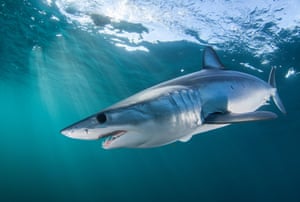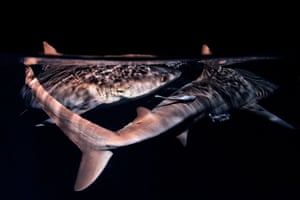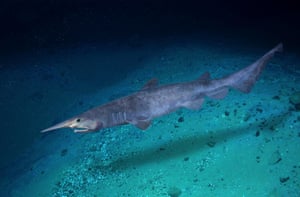-
Most scary
A great white shark in False Bay, South Africa.
Photograph: Arco Images GmbH/Alamy

-
Most efficient hunter
A great white shark breaching as it hunts seals in False Bay, South Africa. Sharks breach when hunting fast-moving prey.
Photograph: Alfred Weissenegger/REX/Shutterstock

-
Fastest
A mako shark at Cape Point, South Africa. The shortfin mako is the fastest species of shark.
Photograph: Nature Picture Library/Alamy

-
Biggest
Whale sharks are the largest sharks – and fish – in the sea. They feed on plankton, which they filter through their mouth, and can grow up to 40ft.
Photograph: Clare Prebble/Marine Megafauna Foundation and University of Southampton

-
-
Smallest
Dwarf lantern sharks are 6 to 8 inches long, rarely seen and live in very deep waters, mostly around the Caribbean. They were only discovered in 1964.
Photograph: Chip Clark/Courtesy of Smithsonian Institution

-
The night hunters
Two grey reef sharks off Papua New Guinea. They are classed as near threatened on the International Union for Conservation of Nature (IUCN) red list because of fishing and the loss of their coral reef habitat.
Photograph: F1online digitale Bildagentur GmbH/Alamy

-
Longest lived
Greenland sharks, such as this one off Canada’s Northwest Territories, have the longest lifespan of all vertebrate species (between 300-500 years).
Photograph: Paul Nicklen/National Geographic Creative/Getty

-
Most elegant
Two blue sharks look like they’re dancing off the coast of County Cork, Ireland.
Photograph: George Karbus Photography/Getty/Cultura RF

-
-
Creepiest
A goblin shark off Portugal. Goblins have a long snout covered in sensors for detecting electric fields in the deep, dark waters where they live.
Photograph: Paulo Oliveira/Alamy

-
Weirdest looking
A juvenile scalloped hammerhead shark in the Pacific near Hawaii. One theory says their head shape allows the shark to scan a wider ocean area through its sensory organs.
Photograph: Biosphoto/Alamy

-
Bravest
A cookiecutter shark alongside a bluntnose sixgill shark complete with bite mark. Cookiecutters have been known to take on whales and much larger sharks, approaching from below, latching on and taking a bite.
Photograph: Paulo Oliveira/Alamy

-
Seen in UK waters
A common angel shark, which is now listed as critically endangered on the IUCN red list. More than 50% of British sharks are listed as threatened or near threatened.
Photograph: Kelvin Aitken/Alamy

-
-
Biggest mouth
Basking sharks off the west coast of Scotland. These plankton feeders can grow to 10m in length but are considered vulnerable and are protected in the UK.
Photograph: Grant Henderson/Alamy

-
Most fearsome
A tiger shark glides over the sandy seabed in shallow water off the Bahamas. Its name comes from its hunting prowess and markings.
Photograph: SeaTops/REX/Shutterstock

-
Most feline
A small-spotted catshark, so-called because of its elongated, cat-like eyes. All sharks have a layer of reflective cells behind their retina allowing them to see better in deep, murky waters.
Photograph: Mark Kirkland/British Wildlife Photography Awards/PA
